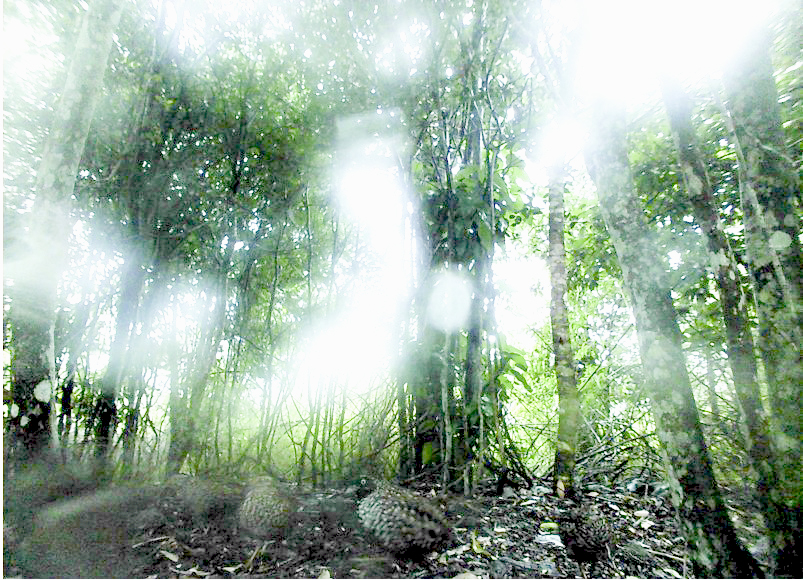

The old saying that “the dose is the poison” (i.e. the amount taken is what causes the poison”) may soon be joined by another, when talking weedkillers and humans, that “the formulation is the poison”.
The news that has ruled Monsanto is liable for a terminally ill man’s non-Hodgkin lymphoma cancer and has awarded him $289 million in damages is generating a lot of attention worldwide. This could be the first significant crack in the company’s carefully crafted armour against claims that its glyphosate-containing products are carcinogenic.
It must also be giving considerable encouragement to what the complainant’s lawyers say are more than 4,000 similar cases across the US.
It will be interesting to see whether the ruling is based strictly on the active chemical glyphosate as the causative agent, or whether the formulation containing the glyphosate is cited as the carcinogenic factor.
An article in the Guardian back in May pointed out that “while regulators have previously required extensive testing of glyphosate in isolation, government scientists have not fully examined the toxicity of the more complex products sold to consumers, farmers and others.”
A summary of the results of tests done under the US National Toxicology Program’s (NTP) first-ever examination of herbicide formulations made with the active ingredient glyphosate stated that glyphosate formulations decreased human cell “viability”, disrupting cell membranes. Cell viability was “significantly altered” by the formulations, it stated. This is not the same as saying that the formulation is cancer-causing, but that it harms human cells.
The Guardian’s May article goes on to say:
“… internal company emails dating back 16 years, which emerged in a court case last year, offer a glimpse into the company’s view. In one 2003 internal company email, a Monsanto scientist stated: “You cannot say that Roundup is not a carcinogen … we have not done the necessary testing on the formulation to make that statement. The testing on the formulations are not anywhere near the level of the active ingredient.” Another internal email, written in 2010, said: “With regards to the carcinogenicity of our formulations we don’t have such testing on them directly.” And an internal Monsanto email from 2002 stated: “Glyphosate is OK but the formulated product … does the damage.”
It will be interesting to see whether these emails played any role in the jury’s decision.
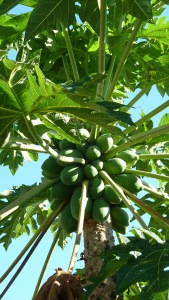 Last year we reluctantly pulled out the last of our pawpaw trees. This was because we were not able to keep the black spot fungus under control sufficiently to be able to harvest fruit of a quality we were prepared to eat. It was a very difficult decision because there is nothing more delicious than a tree-ripened pawpaw.
Last year we reluctantly pulled out the last of our pawpaw trees. This was because we were not able to keep the black spot fungus under control sufficiently to be able to harvest fruit of a quality we were prepared to eat. It was a very difficult decision because there is nothing more delicious than a tree-ripened pawpaw.
This tree and another which we dug out few years back were planted ten years ago and probably gave us about a tonne of fruit over that time.
The black spot fungus didn’t show up in the first 2-3 years, and during that time it was not unusual to have more than 20 fruit on each tree at one time, and to harvest a fruit every couple of days at the height of the season.
However, once the fungus became established for many years we were harvesting smaller than normal fruit which did not have the full “ripe pawpaw” flavour and was infected with white spots which we cut around.
We tried a range of approaches to controlling the fungus, including spraying with wettable sulphur and Seasol. Unfortunately without any clear guidance as to how often to spray, and without any certainty that these were the correct measures to take, combined with long periods away from home, we didn’t persist with any particular regime.
However we did get the impression that both the sulphur and the Seasol had some beneficial effect, but only in the presence of good soil health and regular fertilizing.
Today I came across a post on Jerry Coleby-Williams’ website on how to fortify your pawpaw plants to better withstand the effects of this exotic fungal disease caused by the fungus Asperisporium caricae.
What he recommends is a combination of:
Jerry emphasises that well nourished pawpaws are more important for disease control than spraying. Go to his website to see what he prescribes in detail, particularly the advice on the nutritional requirements for pawpaws.
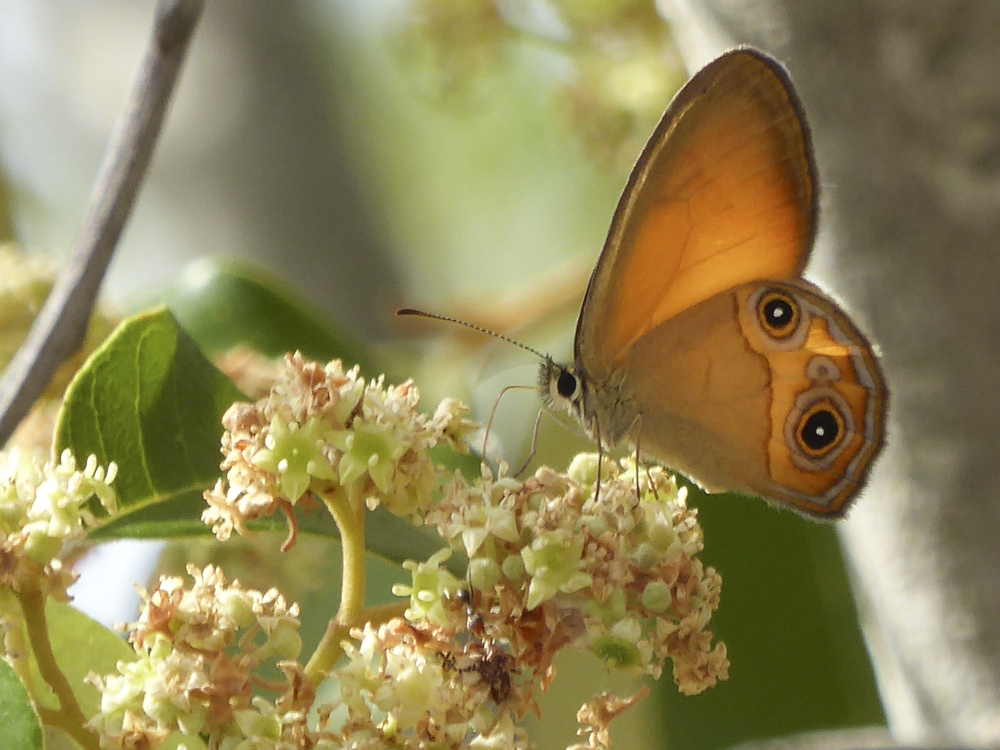
Orange Ringlet (Hypocysta adiante)
These Orange Ringlets are often around our place, either on something that is flowering, or “resting” in grass or leaf litter.
This one is on the flowers of a Soap Tree (Alphitonia excelsa).
While checking my ID of this species I realised that I have a range of links that could be useful to other people who want to identify a butterfly.
Actually I usually start with a field guide: The Butterflies of Australia, by Albert Orr and Roger Kitching. It’s a fantastic book, and in addition to the thousands of paintings of different species and different life cycle stages it has a lot of informative text. “Field guide” is a bit of a misnomer though. While it is softcover it is also large and heavy, more something that you might carry in your day-pack, if weight wasn’t a consideration.
My usual first stop on the internet is the butterfly index page on Brisbane Insects. Peter Chew has created a fantastic public resource with this website. It has a huge range of insect and spider photos with explanatory text. Over the years he has improved the site by adding index pages for the different groups and his butterfly pages are a good example of this.
On the butterfly page you will find thumbnails of typical examples of each group with links to the detailed photo pages.
Of course Peter’s species are limited to those you will find the greater Brisbane area, but though we are 100km west of Brisbane it is still a good source for anything on our place.
[this list is under construction – please check back later for more links]
Australian Butterflies has a great thumbnail index page with good (and bigger than thumbnail) images to help you sort out what your butterfly might be. Generally lots of photos of each species, and often with caterpillar and chrysalis.
Australian Butterfly Photos on Deane Lewis’ Australian Nature Photography site has a reasonable range of images but suffers from not allowing you to see all his photos of one species on the same page.
Butterflies of Australia by Tobias Westmeier should perhaps be called Butterflies of the Sydney Region, but it does have a wide range of butterfly species and has excellent notes on appearance, wingspan, season, range and habitat. The website design is excellent and the Families and Sub-Families are all on the one page, with very good thumbnail shots. Frequently has multiple photos of a species. Includes butterflies of Germany, but all pages which are relevant to Australia are in perfect English.
Butterflies of Australia (Australian Butterfly House) This site has possibly the most complete set of photographs of Australian butterfly species, and particularly photos of eggs, caterpillars and cocoons. However, too many of the photos of butterflies are of museum specimens, even where the species is relatively common. It is not typical to see butterflies in the pinned specimen position, or with the faded colours of museum specimens. Unless you are trying to ID a caterpillar or cocoon, this would be a site to come back to if other sites haven’t yielded an ID.
In the Planning and Environment Court on the morning of 23 January, the Judge dismissed Drywound Pty Ltd’s Appeal against the Council’s decision to refuse the application for a material change of use to allow the establishment of a motocross facility on the land in Adare Road.
It’s over.
The Council’s decision to refuse the Development Application stands.
The voices of the 232 objecting submitters to the Development Application have prevailed.
Colby Steer, the Director of Drywound Pty Ltd, was self-represented at this last hearing after his lawyer had withdrawn as a result of unpaid bills and a lack of response to his emails and phone calls since mid-December 2016.
Some time in early 2015 some members of our local community group, Lockyer Community Action Inc. organised a petition on Change.org for a campaign we were running.
At the time those who set it up, and some of those who signed on to our petition, expressed some concern about the apparently money-oriented nature of the interaction.
At the time I recognised the feeling of unease about the way, some time after I’d signed a petition I’d frequently get an email with a message like:
You signed this petition. Help it reach 25,000 signatures.
Share this petition
or promote it by contributing $5 or more
Over the intervening couple of years that feeling has increased, but it’s only today that I finally decided to do something about it. I googled “what is change.org?” and got a range of views on the organisation, with probably the majority pointing out that it is a “for-profit” organisation, rather than the “not-for-profit” that many people assume (a misunderstanding which the Change organisation doesn’t seem to do much to counteract).
Ben Rattray founded Change.org in 2007 and in 2010 it adopted its current petition mode. Since then it has become one of the biggest sites on the Web for anyone seeking to pressure politicians, corporations or others with a public shame campaign.
How does it make its money? According to Forbes.com in 2012, “Change.org charges groups for the privilege of sponsoring petitions that are matched to users who have similar interests. For example, when a person signs a petition about education and clicks “submit,” a box pops up and shows five sponsored petitions on education to also sign. If a user leaves a box checked that says “Keep me updated on this campaign and others,” the sponsor can then send e-mails directly to that person. It’s not clear from the check box that your e-mail address is being sold to a not-for-profit.”
And, or course, then there are the $5 donations that users are asked to provide to help promote the cause they signed up for. I’ve always thought that was a bit strange. You are in the business of helping people to create effective petitions and to spread them to a wide audience, so why do you need a $5 donation from me to make it more effective – and how will you do it? That’s never explained.
The Forbes.com article in 2012 said that at that time Change.org had 300 paying clients, including Sierra Club, Credo Wireless and Amnesty International.
On their website Change.org explain that the business “is a social enterprise and a certified B Corporation. B Corporations are held to high standards of social and environmental performance, accountability, and transparency set by B Lab, an independent certifying group.”
They also publish a list of ways in which they make their money. But I bet you never saw a link to that information on one of their web pages asking you to donate to promote a petition.
The Widipedia entry on B Corporations and their certification points out that “The B-Lab certification is a third party standard requiring companies to meet social sustainability and environmental performance standards, meet accountability standards, and to be transparent to the public according to the score they receive on the assessment. B-Lab certification applies to the whole company across all product lines and issue areas. For-profits of all legal business structures are eligible for certification.”
Read that last sentence again.
Soooo … have I changed my feeling of unease about Change.org’s business model? No, but I now have a clearer understanding of what it is.
Will I continue to sign Change.org petitions? Yes, when it is something that I feel is important and after I have carefully examined the petition and the body behind it and am comfortable that it is not “green-washing” of something unacceptable.
Will I “donate” (=pay) Change.org to promote a petition I have signed. No. Never have and never will. But I won’t judge you if you do, because I think that there are trade-offs involved in so many of the social and commercial transactions we all have to make every day, and we each have the right to make our own judgements.
I hope Glenda doesn’t mind my moving her comment into a new blog post to make sure her ideas are visible to more people. I know that many people don’t scan comments to blogs unless they are really interested in the topic under discussion. Glenda says:
Hi thanks for your update on the dragons, I am at Minden and have also had a lot of activity with my plants I have so far counted 60 buds over 3 dragon poles and have so far had approx 15 flowers that opened,I also I have 5 fruit that are developing at a very rapid rate. I did very little pruning this year because of the long cool season I missed the opportunity as I did not want any further damage from frosts, my dragons have really been powering on and all of my buds are on old growth so far, I have given my plants a good soaking with “seasol” liquid fertiliser and today I am going to throw a handful of blood and bone around the base just to give them a bit of an edge. I have 6 new poles with the red flesh variety but I doubt that I will see any flowers this year, actually I am a bit disappointed with these plants as they seem to be a bit retarded with their growth so far, maybe next year for them. I am really looking forward to the plants peak in budding however my worst fear is that fruit fly will get the taste for the fruit, have you had any trouble in this area, I have read that fruit fly can be a problem. Like you I seem to have lots of ants that seem to be all over the buds so I am hoping that they deter the fruit fly ( your thought would be appreciated).
Here’s my reply:
That’s interesting about your already having 60 buds over three poles – I assume that is three plants? I made the mistake of following advice that the red variety grow better on a horizontal beam whereas the white ones grow better on poles with “spreader” frames at the top. The decision was also influenced by wanting to try growing them in a shadehouse and on a heugelklultur base.
If you are not sure what heugelkultur/hugelkultur is have a look at this site. There are plenty of other sites on the net, but this one explains it well and is not too far from what we have done here. I’ve been meaning to write something about the design of our beds, but every time I start I run up against the fact that while I was I was too busy and too dirty and sweaty to stop digging and get the camera.
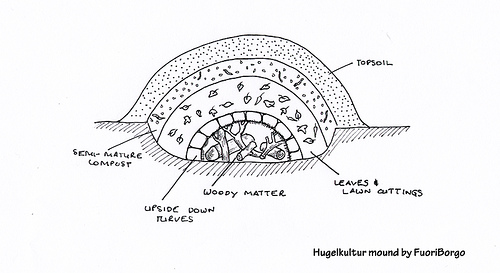
A general schematic of a heugelkultur mound incorporating a trench
Anyway, back to poles vs beams. Our three plants are growing up the posts supporting two horizontal beams, each about 1.5-2m long. – see photo below This doesn’t provide anything like the support for growing lots of branches that three posts with frames would have done. I’m pretty sure this is why Glenda has 60 buds to our 29 (Glenda I’d love to have a photo of your poles to use here).
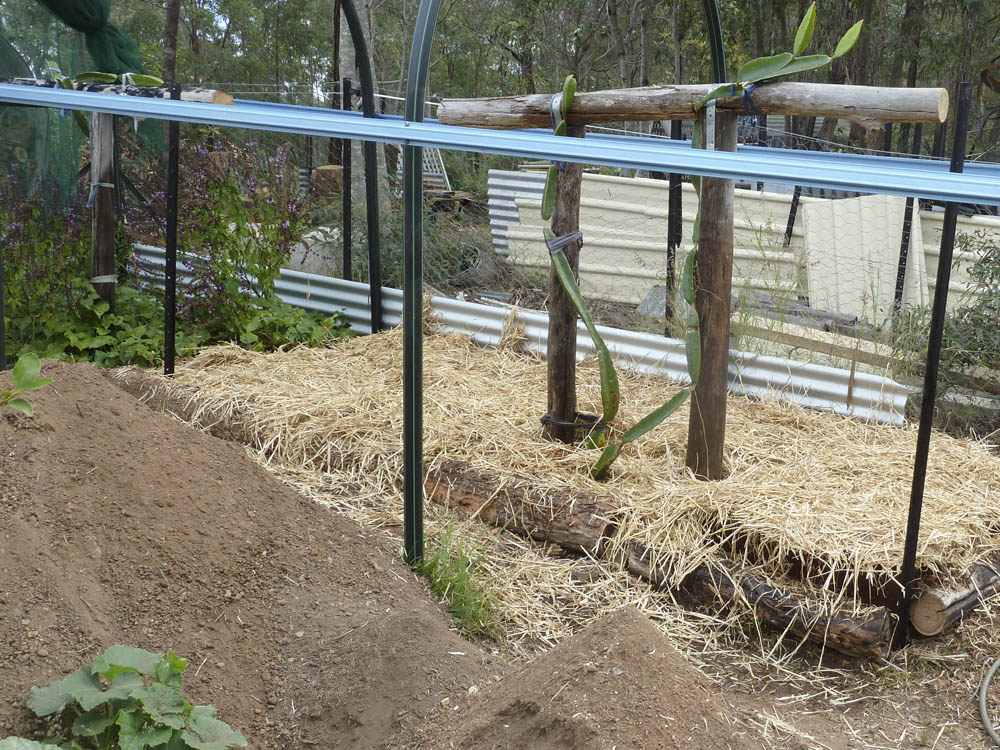
Beam trellis – in two sections (you can just make out the second section on the left). This started out as one long beam, but that restricted access to the back of the garden too much so I cut out a section. The area under the straw is the newly created heugelkultur bed – the area to the left under sweet potato was done about 12 months earlier. The heaps of soil on the left have been dug and sieved from the 2nd Huegelkultur Shadehouse. Date of this photo is July 2013.
Other factors?
There is only about 20km between our properties, though Glenda might have an edge over our poor and stony sandstone soil.
The climate is pretty much the same, with the biggest difference being that because we are on a high ridge we never get frosts – the cool air slides off the ridge into the valley before the temperature gets down to frost level.
Another difference is that we are growing one of the deep red varieties, whereas I assume from what Glenda says she has a white variety. The two varieties may have different numbers of fruit in our climate.
And of course, our garden has been pretty much neglected while we have been fighting the motocross facility proposal for the last two years. I haven’t made a single batch of compost in that time.
Regarding fruit fly, we have never had a fruit fly problem with out Dragon Fruit. I suspect that the thick skin offers some protection. It’s also interesting that the parrots have not yet attacked our Dragon Fruit. The shadehouse is not closed in, but only has 30% shadecloth draped over the frame and down to the blue batten you can see in the photo above. Normally the parrots would find any interesting fruit in this sort of structure.
I have to admit that I have not found good information anywhere on how to prune Dragon Fruit. What I am going to tell you here is a result of my own “trial and error” approach over several years. It seems to work for me, but who knows whether there is a better approach that I don’t know about that might yield a whole lot more production.
Our plants are around 4 years old and last year they produced over 40 fruit (I stopped keeping records after 40, so the total could have been over 50). Probably because of our cool and dry winters our Dragon Fruit go dormant in the winter, with very little new growth and no flowers. Fruit is produced between January and June.
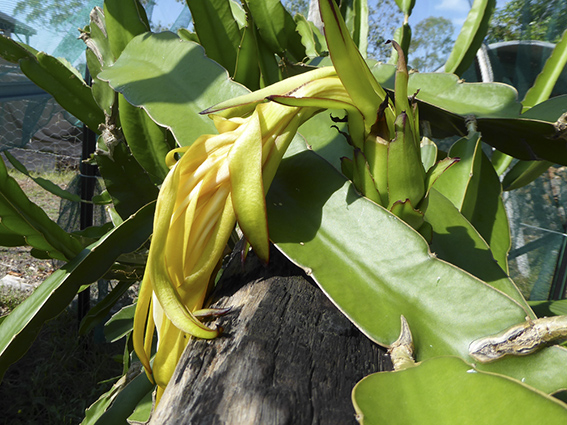
Three days after flowering
We had the first bud on our three plants on 6 December, and it flowered on 18 December this year, though I didn’t get around to photographing it until yesterday (21st). This was three weeks earlier than the first flowering last year.
On the 20th I carefully counted all the buds that had appeared since the 6th – in two weeks we had gone from one bud to 29.
These plants were partially pruned in November, but then I got too busy to finish the job. But this has given me the chance to think about the effect the pruning might have had on bud location, though this is all guess work and observation – no evidence-based theory here.
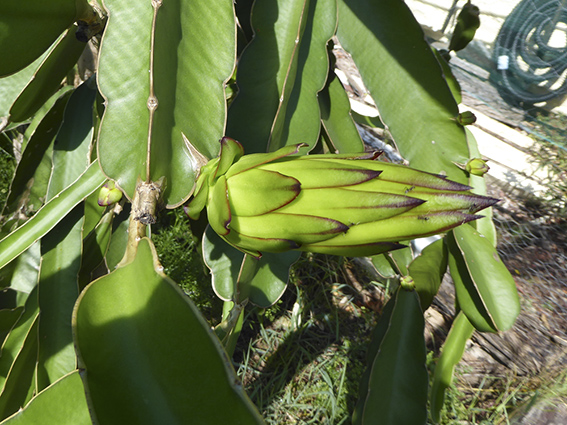
A range of buds, from just appeared to on the way to flowering. Note the ants on the bud.
What I am seeing this year is similar to what I have observed in other years. The most buds (by far) appear on downward growing branches. In addition, there are far more buds on branches that have been pruned (whether the pruning was done by chopping off the branch through the green section or cutting it off at a node) than on un-pruned branches.
As you can see in the photo above, ants take a great deal of interest in the buds, but they do not seem to do them any harm. I suspect that the buds exude something that is useful to the ants, and maybe in return the ants discourage insects that may be harmful to the bud. Does anyone have any information on this?
The photos below show buds formed near the pruning point, however not all of the buds on a pruned branch are this close to the pruning point. Nevertheless, as I said above, by far the most buds are on pruned branches.
It doesn’t seem to matter whether the pruned branch has grown some more branches at the pruning point. Many of the branches I pruned in November have done this, but they still have buds on the pruned section – and not on the new, un-pruned branches.
Another factor to think about (maybe before you plan your Dragon Fruit planting) is whether you will grow them on poles with spreader frames on top or horizontal beams. You can see a short discussion here.
If you are just starting out with Dragon Fruit, remember that they should not be pruned until they are at least one year old, and ideally not until they have had one good flowering and fruiting season.
Would you like to share your pruning techniques here, along with your observations on the results?
If you are looking for more information on Dragon Fruit, have a look at the links at the end of the this post from the end of 2014. And if you want to see the layout of our vege garden have a look at the two plans in this post. The first shows how the vege garden fits into the overall plan on our narrow ridge top. Scroll down for a more detailed plan of the vege garden. The Dragon Fruit are growing in Hugelkultur Shadehouse No.1.
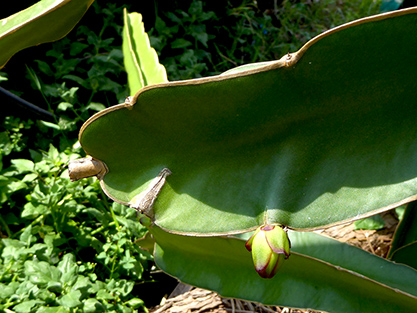
Branch pruned at the node
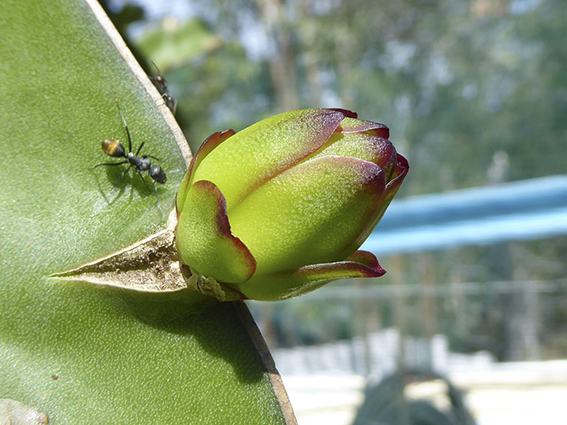
Bud a few days old. The ants seem to take an interest in them right from the time they form
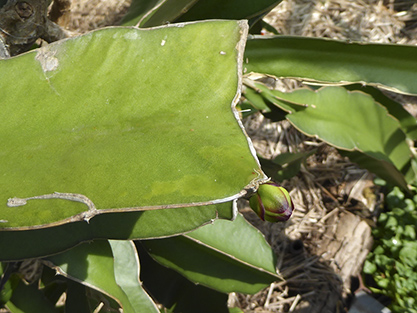
A bud right at the pruning point – chopped through the green section
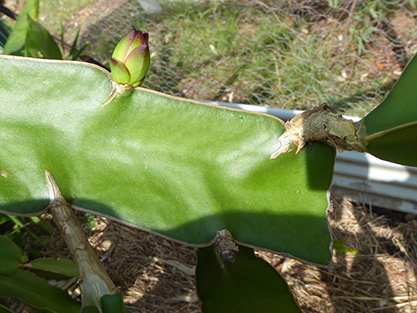
Branch pruned by chopping through the green section
Last month Amsterdam city council published a plan to rid the city of gas-fired cooking and central heating by 2050. Next year, the aim is to remove 10,000 housing corporation homes from the gas network, city alderman Abdeluheb Choho said. In addition, two new residential areas are already being built without links to the gas network.
The above article is re-posted from DutchNews.nl where it appeared on Wednesday 7 December 2016
This is only one small demonstration of the lack of information available to the Australian population about what other countries are doing. The Commonwealth and State governments make the most of this to try to convince us that what they are doing is in line with the rest of the world, when the reality is that we are one of the global laggards in reducing greenhouse gas emissions.
Some of the most spectacular wildlife in the Lockyer Valley isn’t necessarily the big stuff like kanagroos, koalas or kookaburras. The small stuff can be absolutely entrancing.
The Large Cuckoo Wasp above is one example. It was found dead on the floor in our house (hence the bits of detritus caught up in its exoskeleton). Before you start thinking that we are a bit casual with our housekeeping, the critter itself is less than 20mm long, so the “fluff” is actually fairly minute particles. Having said that this species is so small, it is known as the Large Cuckoo Wasp, which suggests that in general Cuckoo Wasps are pretty small insects.
Just how small they are can be seen in the image below.

The individual in the photo at the top of this page is on the right here. The one on the left is a different species (one of the two shown below). This Australian 20 cent coin has a diameter of 28mm.
The females of these wasps parasitise the nests of mud wasps, laying their egg in the mud nest next to that of the host species. If they are discovered in the nest they roll into a ball like an armadillo, to protect themselves from the sting of their much larger host with the armour plates of their outer skeleton. It seems to be a common feature of Cuckoo Wasps that the surface of the exoskeleton is pitted; perhaps to increase its strength, or to foil the probing sting of an angry mud wasp? The defensive posture is often also used if they are threatened in some other way – such as a human trying to capture them.
The “appendage” at the rear is the ovipositor, used for laying eggs. I’m curious about the structure of this ovipositor – you’d think that an insect that just lays its egg in the open nest of another wasp wouldn’t need something as robust as this to do the job. Some other species of parasitic wasp have large teeth on the ovipositor in order to ‘drill’ through wood to reach their host(1). For example, in the sawflies the ovipositor is saw-like and is used to insert the eggs into plant leaves, stems or wood(2). Is this a relic from a previous evolutionary stage?
Large Cuckoo Wasps feed on the nectar of flowers in the woodlands, heaths and urban areas which are their habitat.
For a beautiful image of this species, have a look at this shot from Stanley and Kaisa Breeden.
After we found the second, smaller Cuckoo Wasp (dead on a window ledge in the house), and than another small one, I contacted Ken Walker at Museum Victoria and offered to send him the specimens to be identified. Ken was happy to do this and to send me photos of the specimens.
Not only did Ken take fantastic photos, he also spent a lot of time cleaning up all the dust and debris off the specimens and then “relaxing” them so that they could be properly displayed. Compare the photo on the left immediately below to the one at the top of this post – they are the same specimen.
Here are some of his photos. These are photos of the most “diagnostic” parts of the bodies. The scale bars for the whole body photos are 5mm for the top photo and 2mm for each of the others.

Stilbum cyanurum (Photo Ken Walker)

Praestochrysis lusca (Photo Ken Walker)

Chrysis lincea (Photo Ken Walker)
You can find more about this species at the following links:
http://www.brisbaneinsects.com/brisbane_parawasps/CuckooWasp.htm
https://baynature.org/articles/the-cuckoo-wasp-a-gorgeous-parasite/
(2) http://www.qm.qld.gov.au/Find+out+about/Animals+of+Queensland/Insects/Wasps+and+bees
http://www.bowerbird.org.au/observations/60098
Thanks to Ken Walker from Museum Victoria for his willing assistance with identifying these species, and for the many other times when he has provided helpful advice on invertebrate wildlife. Ken is the driving force behind Bowerbird, a huge job which he undertakes in addition to his many other duties, and he manages to produce the monthly issue of the Bowerbird Bugle newsletter.